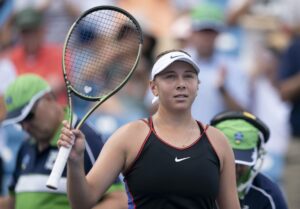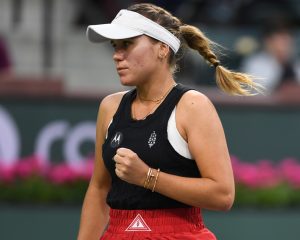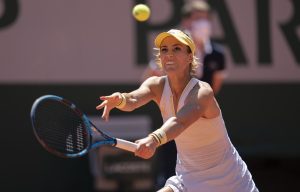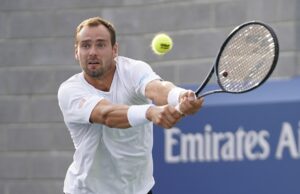Hamburg 2007 and Madrid 2009. What do these tournaments have in common? They are the only two times that Roger Federer has managed to defeat his nemesis on a clay court. Whilst their magnificent rivalry is one of the best in tennis history, on the terre battue it has never been close. Nadal leads the clay court head-to-head between the two 13-2, and has scored five unanswered wins at Roland Garros. But those two wins in Hamburg and Madrid, particularly the latter, were special victories for Federer. The question is: How did he do it?
The biggest problem for Federer in this matchup is his inability to hit through his backhand in the face of Nadal’s topspin heavy forehand. It’s dangerous for Federer on any surface, but even more so on a clay court, with the high bounce taking it out of easy reach for Federer’s one-handed backhand. In 2017 Federer seemed to have finally found the solution to this problem, claiming four wins over Nadal at the Australian Open and in Indian Wells, Miami, and Shanghai, by refusing to give ground and half-volleying the ball off the baseline from that wing.
It was a tactic made possible by his switch to a larger racquet face, but the two have not faced one another on clay since Federer made that change. Indeed, their last match on clay came in the 2013 Italian Open final, with the Spaniard winning 6-1 6-3. As a result, despite this being the 39th match of their rivalry, there is a degree of mystery as to how this match will pan out. Which makes an investigation into Federer’s last win against Nadal on the clay well-worth pursuing, to see how his revised tactics might fare on clay.
2009 Madrid Open Final – Federer wins 6-4 6-4
There are two factors that make this win much less impressive than it might at first appear. First of all, Madrid is a city located at a high, altitude meaning that the ball flies through the air a lot faster than at most clay-court tournaments, including the French Open. The Spaniard also showed visible signs of weariness, having broken the record for the longest three-set match in defeating Novak Djokovic the day before in a third set tie-break after saving three match points. Lacking strength in the legs and dynamic movement is typically of great importance in matches between two players of a similar level, as the recent Rome final illustrates.
After getting passed with a running down-the-line forehand in the very first game, Federer was afraid to approach to that side. He then became slightly guilty of over-hitting to the Nadal backhand, getting caught in awkward positions. Despite being one of the most tactically aware players on the tour, the Swiss has always looked like a confused junior against Nadal. He came into that match on a five-match losing streak against the Spaniard, including the 2008 Roland Garros, the 2008 Wimbledon and the 2009 Australian Open finals. Federer, in fact, looked almost incapable of defeating Nadal.
But having kept the match close, his breakthrough came at 4-4 in the opening set. At 30-30, Federer targeted the Nadal backhand again, finally drawing a weak response after some excellent depth and finishing with a forehand winner that just clipped the line. Break point conversion was, and still is, one of the Swiss’ biggest liabilities and it wasn’t looking good as he got caught in a cross-court exchange between his backhand and Nadal’s fearsome forehand. But, forcing the ball to the line, Federer broke down Nadal’s will to steal the first break of the match.
From there, Federer looked a different man from that point, displaying the sort of confidence he has against most players. He quickly sealed the first set and continued his fine play early on in the second. A fantastic rally ending with a forehand inside-in winner and a perfect backhand drop shot gave him a break point at 2-2. Nadal responded by missing a straightforward forehand. Federer did lack a little composure in his attempt to serve it out, but recovered well from two break points down to take the match 6-4 6-4 on his second match point with an ace down the T.
How did he win it after all?
As good a win as it was for Federer, ultimately it must be admitted that his victory was mostly due to Nadal’s weariness. He just didn’t have the energy to impose himself and as a result allowed Federer to attack more freely than he usually can against Nadal.
Looking at it from a statistical point of view, there a few main points that stand out. First of all, Federer took 37 out of 50 short rallies on his own serve and didn’t find himself grinding it out in many long ones. He also emerged victorious from the most important rally of the match, winning a 23-shot exchange down break point in the last game of the match.
His shot selection was on point throughout the match. Federer has a huge repertoire of shots, but he does have a tendency of overusing or simply using them at the wrong moments, particularly against Nadal. But in Madrid, he avoided it and each little rhythm-breaker like a drop shot or a serve-and-volley attempt was deployed at the right time. It was a clinic in how to beat an opponent not at his best.
The keys to the match
Great battles in tennis are often fought in the minds of the players. The reason why Federer arguably stands a chance against Nadal this year is that he can go into the match with nothing to lose. At Roland Garros between 2005 and 2008 the Swiss was unsure whether he would ever win the one Slam that continued to elude him. But his 2009 triumph took a lot of pressure off him and in 2011 he was able to play his best match at Roland Garros, acquitting himself well in a four set defeat to Nadal in the final. In 2019, Federer arrived in Paris not having played this tournament in four years. As a result, little was expected of him and just being in the semifinals is a significant achievement.
Roger Federer is probably the most confidence-driven player on the planet. He often seems nervous at the beginning of a match, only to start playing brilliant tennis as soon as he catches a lead. That’s exactly what happened in the Madrid match. He was able to put away that mental block he had against the Spaniard and play some old-school, hyper-aggressive tennis. In 2019, the ghosts of the past should already be long gone after having defeated Nadal five times in a row.
Nadal targeted only four serves in that Madrid match to Federer’s forehand and ten years later it won’t be any different. The racquet change and ageing may have limited the power of Federer’s best shot, but it’s still a formidable weapon and Nadal will need to avoid giving him short balls to the forehand side. But the Swiss can’t generate the sort of power from the baseline that he could in 2011 when he played probably his best match against Nadal at Roland Garros.
Federer has to be ready with for the backhand returns he’ll have to hit and he has to make sure most of them are topspin because chips will do no harm to Nadal on clay. Defensive slices are going to let the Spaniard play inside the court and that’s one thing Federer can’t afford. His topspin backhand has to work as well as it did today against Wawrinka or in that Australian Open 2017 final.
Serving well is obviously a must, so is a decent break point conversion. In the Madrid final, he capitalized on both chances he got and that proved crucial. Another key factor in this matchup is often the first set as Federer has defeated Nadal just twice after dropping the opening set, and both came very early in Nadal’s career.
It’s quite remarkable that that at 37 years old, Federer might have his best ever chance to defeat Nadal at Roland Garros. But looking at how well the Swiss performs when the underdog (2017 Australian Open anyone?) it seems foolhardy to rule him out.
Main photo:
Embed from Getty Images






